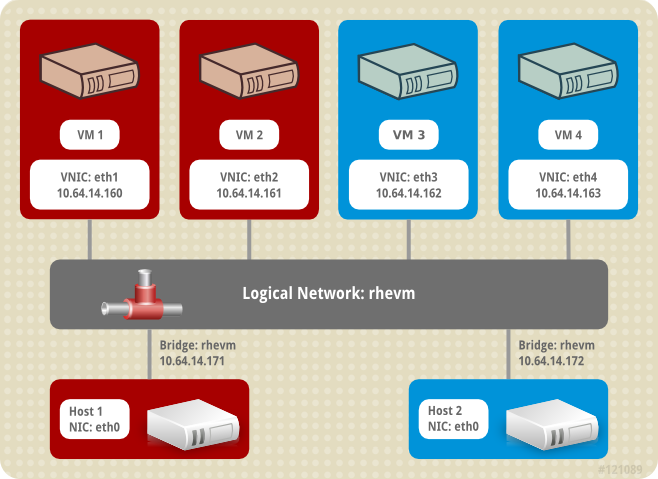3.11. Logical Networks
Logical networking allows the Red Hat Enterprise Virtualization environment to separate network traffic by type. For example, the
ovirtmgmt network is created by default during the installation of the Red Hat Enterprise Virtualization to be used for management communication between the Manager and hosts. A typical use for logical networks is to group network traffic with similar requirements and usage together. In many cases, a storage network and a display network are created by an administrator to isolate traffic of each respective type for optimization and troubleshooting.
The types of logical network are:
- logical networks that carry virtual machine network traffic,
- logical networks that do not carry virtual machine network traffic,
- optional logical networks,
- and required networks.
All logical networks can either be required or optional.
Logical networks are defined at the data center level, and added to a host. For a required logical network to be operational, it must be implemented for every host in a given cluster.
Each virtual machine logical network in a Red Hat Enterprise Virtualization environment is backed by a network bridge device on a host. So when a new virtual machine logical network is defined for a cluster, a matching bridge device must be created on each host in the cluster before the logical network can become operational to be used by virtual machines. Red Hat Enterprise Virtualization Manager automatically creates required bridges for virtual machine logical networks.
The bridge device created by the Red Hat Enterprise Virtualization Manager to back a virtual machine logical network is associated with a host network interface. If the host network interface that is part of a bridge has network connectivity, then any network interfaces that are subsequently included in the bridge share the network connectivity of the bridge. When virtual machines are created and placed on a particular logical network, their virtual network cards are included in the bridge for that logical network. Those virtual machines can then communicate with each other and with other objects that are connected to the bridge.
Logical networks not used for virtual machine network traffic are associated with host network interfaces directly.
Figure 3.2. The ovirtmgmt logical network.
Example 3.1. Example usage of a logical network.
There are two hosts called Red and White in a cluster called Pink in a data center called Purple. Both Red and White have been using the default logical network,
ovirtmgmt for all networking functions. The system administrator responsible for Pink decides to isolate network testing for a web server by placing the web server and some client virtual machines on a separate logical network. She decides to call the new logical network network_testing.
First, she defines the logical network for the Purple data center. She then applies it to the Pink cluster. Logical networks must be implemented on a host in maintenance mode. So, the administrator first migrates all running virtual machines to Red, and puts White in maintenance mode. Then she edits the Network associated with the physical network interface that will be included in the bridge. The Link Status for the selected network interface will change from Down to Non-Operational. The non-operational status is because the corresponding bridge must be setup in all hosts in the cluster by adding a physical network interface on each host in the Pink cluster to the
network_testing network. Next she activates White, migrates all of the running virtual machines off of Red, and repeats the process for Red.
When both White and Red both have the
network_testing logical network bridged to a physical network interface, the network_testing logical network becomes Operational and is ready to be used by virtual machines.
